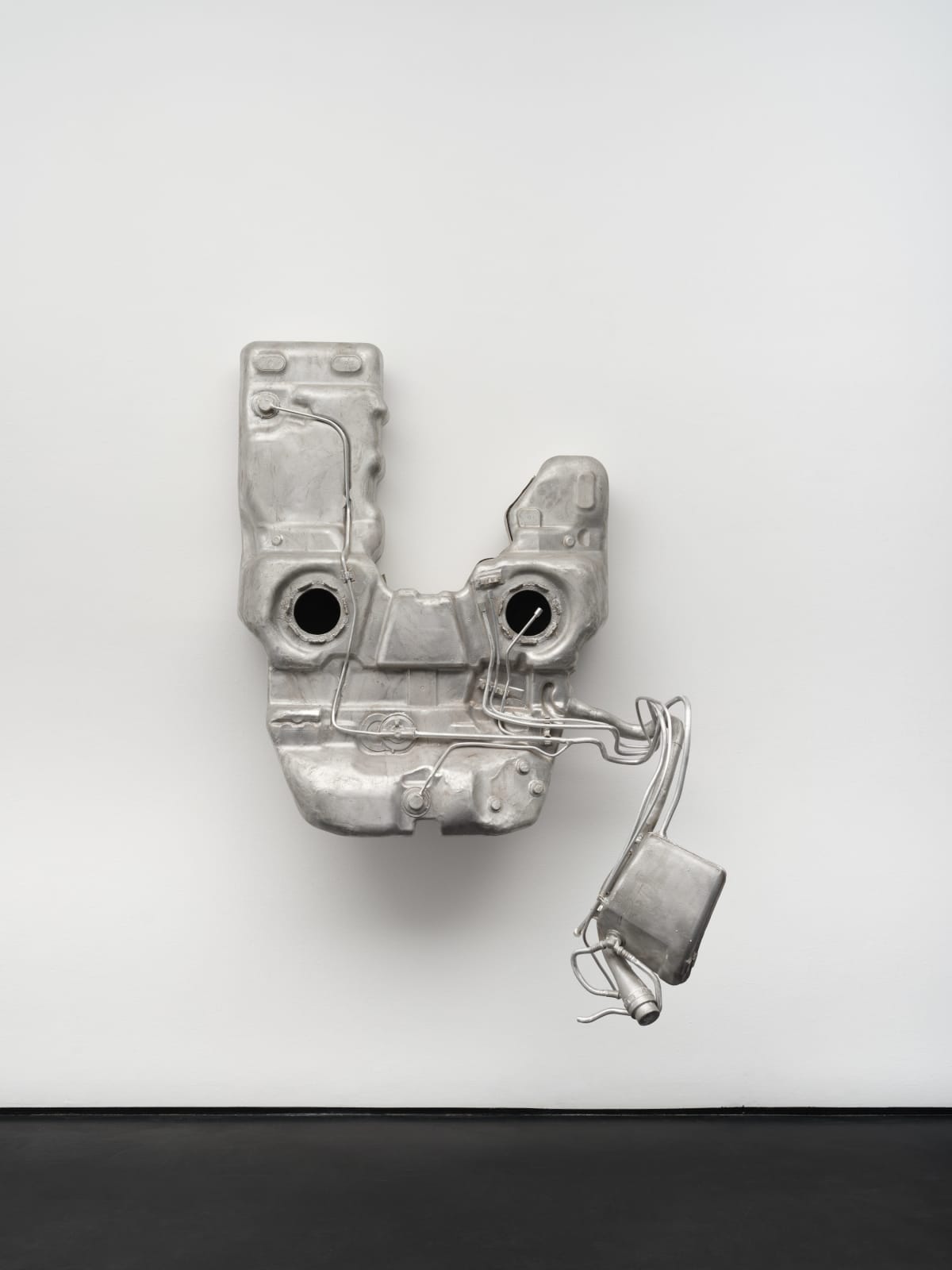Michael Sailstorfer
Tank A1, 2025
Aluminum
180 × 130 × 65 cm
70 7/8 × 51 1/8 × 25 5/8 inches
70 7/8 × 51 1/8 × 25 5/8 inches
Copyright The Artist
Photo: Marjorie Brunet Plaza
Weitere Abbildungen
Die Skulptur „Tank A1“ (2025) zeigt einen aus Aluminium gegossenen Auto-Tank, der ursprünglich im Inneren eines Fahrzeugs verborgen war. Michael Sailstorfer löst ihn aus seinem technischen Kontext heraus und so...
Die Skulptur „Tank A1“ (2025) zeigt einen aus Aluminium gegossenen Auto-Tank, der ursprünglich im Inneren eines Fahrzeugs verborgen war. Michael Sailstorfer löst ihn aus seinem technischen Kontext heraus und so wird er zum eigenständigen Objekt, das wie eine überdimensionale Maske an der Wand hängt. Zwei runde Öffnungen erinnern an Augen, während geschwungene Leitungen über die Oberfläche verlaufen, ähnlich Adern oder Nervenbahnen. Die zunächst rein technische Form erhält eine anthropomorphe Qualität. Der Künstler beschäftigt sich seit fast zwei Jahrzehnten mit Maskenskulpturen und erforscht deren Symbolik und Bedeutung. Durch den Einsatz von Materialien wie Metall und Keramik untersucht er sowohl ihre kulturellen als auch futuristischen Dimensionen und integriert dabei oft Elemente aus Architektur und Science-Fiction, um Fragen zu Transformation und Identität aufzuwerfen. „Tank A1“ wird so nicht nur zum Speicher von Energie, sondern auch zum Träger einer beinahe körperlichen Präsenz. Seine metallische Oberfläche trägt Spuren von Bearbeitung und Gebrauch, ist uneben und von Schweißnähten sowie Formspuren durchzogen. Aus einem unscheinbaren Bauteil wird eine Skulptur, die Fragen nach Energie, Materialität und der Grenze zwischen Technik und Körper aufwirft. Als industrielles Ready-Made verwandelt sich der funktionale Tank in ein Objekt, das die Verbindung zwischen Technik und Körper thematisiert.
The sculpture “Tank A1” (2025) features a cast aluminum car fuel tank, originally hidden within the interior of a vehicle. Michael Sailstorfer removes it from its technical context, transforming it into an autonomous object that hangs on the wall like an oversized mask. Two round openings resemble eyes, while curved pipes run across its surface, reminiscent of veins or nerve pathways. What was once a purely technical form takes on an anthropomorphic quality. For nearly two decades, the artist has been working with mask sculptures, exploring their symbolism and significance. By using materials such as metal and ceramics, he investigates both their cultural and futuristic dimensions, often integrating elements of architecture and science fiction to raise questions about transformation and identity. Tank A1 thus becomes not only a reservoir of energy but also a bearer of an almost corporeal presence. Its metallic surface, marked by traces of processing and use, is uneven, crisscrossed with weld seams and casting marks. From an unremarkable automotive component, a sculpture emerges—one that interrogates energy, materiality, and the boundary between technology and the body. As an industrial ready-made, the functional tank is transformed into an object that explores the intersection of machinery and the human form.
The sculpture “Tank A1” (2025) features a cast aluminum car fuel tank, originally hidden within the interior of a vehicle. Michael Sailstorfer removes it from its technical context, transforming it into an autonomous object that hangs on the wall like an oversized mask. Two round openings resemble eyes, while curved pipes run across its surface, reminiscent of veins or nerve pathways. What was once a purely technical form takes on an anthropomorphic quality. For nearly two decades, the artist has been working with mask sculptures, exploring their symbolism and significance. By using materials such as metal and ceramics, he investigates both their cultural and futuristic dimensions, often integrating elements of architecture and science fiction to raise questions about transformation and identity. Tank A1 thus becomes not only a reservoir of energy but also a bearer of an almost corporeal presence. Its metallic surface, marked by traces of processing and use, is uneven, crisscrossed with weld seams and casting marks. From an unremarkable automotive component, a sculpture emerges—one that interrogates energy, materiality, and the boundary between technology and the body. As an industrial ready-made, the functional tank is transformed into an object that explores the intersection of machinery and the human form.
1
von
3













